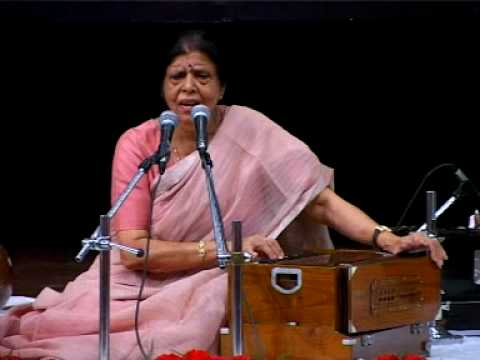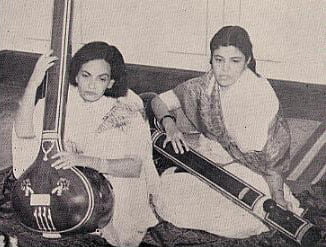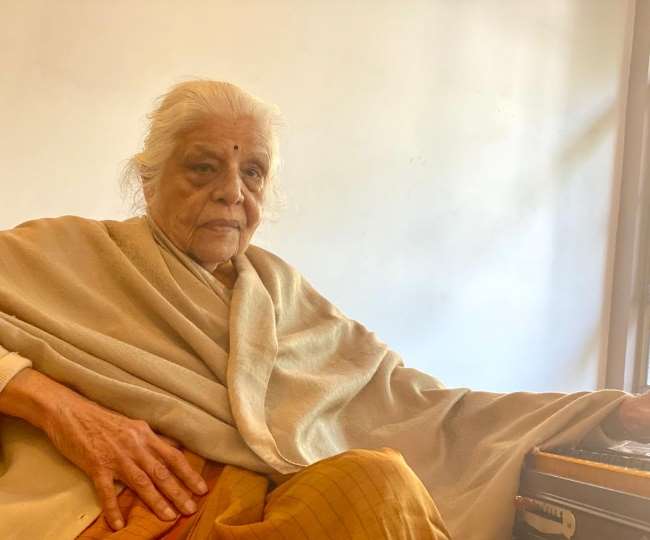Shanti Hiranand a proficient classical Ghazal singer is a prominent name in Hindustani Classical Music. From debuting at the All India Radio Lahore in the year 1947 at the mere age of 14 and to furthering the eminent legacy of Begum Akhtar- dubbed as Mallika-e-Ghazal who is regarded amongst the greatest singers of Ghazal, Thumri and Dadra forms of Hindustani Classical Music.
Shanti Hiranand was born in a Sindhi business family based in Lucknow in the year 1933. Being the province of Nawabs, Lucknow which is also referred to as the City of Nawabs developed immense interest in vivid art forms, particularly in Nritya and Sangeet, owing to which Shanti Hiranand was exposed to classical music at a very early age. She studied at the notable Bhatkahnde Music Institute, training in classical Hindustani Sangeet.

After her family returned to India during the partition of 1947, she continued her musical training under the guidance of Ustad Aijaz Hussain Khan of Rampur. Thanks to her performance at All India Radio in Lahore, she came under light and was appreciated for her excellence. It was because of this small gig at All India Radio that later in 1952 an official at the Radio station suggested her to train under Begum Akhtar.
This brought a transformative turn in Hiranand’s life, and she became one the foremost disciples of the glorified Akhtari Bai Faizabadi well known as Begum Akhtar.
Shanti Hiranand and her guru
Begum Akhtar along with her sister and mother was disowned by her father; she was merely seven when she had a hold of instruments like Sarangi, under the guidance of Ustad Imdad Khan, a great Sarangi exponent from Patna. Later on, Begum Akhtar moved to Calcutta along with her mother where she learnt music from stalwarts of classical Hindustani Music like Mohammad Khan, and Abdul Waheed Khan of Lahore and at last she was trained under Ustaad Jhande Khan.
A skilful artist Begum Akhtar was the torchbearer of several traditions- including one of the musical bonds of guru- shishya paramara, a legacy of talented independent women musicians, which was later carried on by Shanti Hiranand.
Once Shanti Hiranand demonstrated an incident of her accompanying her guru for a show in Pakistan, where they went into the routine check, an official held Shanti’s passport and looked baffled at them, to which Madam Akhtar replied, “dekh kya rahe hai, beti hai hamari,” (what are you looking at, she is my daughter). The passport read the name Shanti Hiranand Akhtar; Begum Akhtar was very fond of Shanti, so she adopted her as a foster child and in return, she was called Ammi.
This relationship continued till Akhtar’s death in 1974. Shanti Hiranand carried out her legacy for more than two decades successfully.

She lived in Lucknow and was a leading member closely associated with BAAG – Begum Akhtar Admirer Group, in an effort to convert Akhtar house into a museum in memory of the singer and carry forward her musical heritage.
It amazes how the two women from seemingly diverse backgrounds, promised themselves an exalted level of understanding, during a time when there was no conducive environment for the growth of women, especially as an artist. Shanti Hiranand belonged to an upper middle–class Hindu family, she had a liberal education and was provided a certain space and freedom to follow her passion while Akhtari Bai Faizabadi had a closed upbringing within a typical feudal home in those days.
Shanti Hiranand was an austere Gandhian while Begum Akhtar had a persona of deep indulgence, which is among the many reasons that make their bonding so special. It is notable that both had admirable support from their mothers and it was they who introduced their girls to the world of music across time. Shanti’s parents never stood in her way she was never stopped from being with her Ammi. On the contrary, it was Shanti’s mother who encouraged her to follow her Guru until the very last.
Owing a tribute to her guru Shanti Hiranand penned down her experiences and decade-long shared relationship of her with Begum Akhtar, in the biography- ‘Begum Akhtar- The Story of my Ammi,’ in which Shanti provided her readers with a philosophical gaze into the hidden side of Begum Akhtar and examines the indelible person that her Ammi was. In the book, she acknowledges the significant role of her Ammi in all her life endeavours.
In an interview she demonstrated the time she received a proposal from the US from a suitable groom, she swore to him that unless her Ammi approves she will not say yes. Sure enough, her Ammi did agree and was the one to choose her groom.
Shanti Hiranand as a performer
Talking about her musical journey in an interview she fairly elucidated what music meant to her: Thumri is one step higher from classical music, and unless it’s in your temperament you can’t sing thumri. Dadra is what you call a sophisticated folk. Ghazal on the other hand is a love song. It is a conversation between lovers, it is mellow, deep and sad, quite like a deer’s tear when it’s been on the run and is exhausted, and knows it’s going to be shot dead. Ghazal does in fact mean a ‘hiran,’ (deer).
Shanti Hiranand with her soul-stirring performances did justice to her sheer dedication to her art and kept alive the style of her guru. The greatness of the Ghazal was depicted not just in the sentiments but in words that express them, and in the voice that brings them to life. She would compose her melody on her own, though she would write in Urdu she never read her notes; ‘Bairon Koyalia na Bol,’ ‘Hamari Aytaria aao Balam Ji,’ ‘Shaam- e- Firaq ab na pooch,’ are among many of her notable works. ‘Dance of the Winds,’ an internationally acclaimed film, has Thumri and Dadra voiced by her in an inimitable style.

Hiranand never forgot her love for radio singing and sang for All India Radio for over 46 years, along with it she continued to perform at Sahitya Kala Parishad, Sanskar and Centre for Performing Arts, her performances promised spellbinding magic on the audience, it left them enthralled.
In 1981, she became the first woman artist of Independent India to perform in Pakistan; a complete album of her performance was presented to the then Indian Prime Minister Mrs Indira Gandhi by a Pakistani legate claiming that Hiranand was the true ambassador of India. Hiranand’s performance always depicted the charisma of her guru which she staged all across the world including Lahore, Islamabad, Karachi, Toronto, Boston, New York, Geneva and Washington to name a few. She was celebrated globally for her music and was honoured by the Council of Asian Indian Associations of Greater Washington, New York’s Sur Sangam Cultural and Educational Organisation and by the Bharti Vidya Bhavan in London.
Hiranand believed that if one sings a sher with a sheer understanding from the heart, it would keep them forever young. Apart from music, Hiranand also starred in the film Siddhartha by Conrad Rooks, she played Siddharatha’s (Shashi Kapoor) mother.

In her last years, Padma Shri Shanti Hiranand was closely associated with the Triveni Kala Sangam in Delhi, she would come straight from her swim at the Gymkhana, and together with the Tanpura and Tabala player would tune in to music and enter the world of mehfil. She dedicated most of her time to imparting her musical talent to students at the Triveni Kala. She enjoyed singing the poetry of Mir Taqi Mir, Jigar, Momin and others. She was of democratic view, and never believed in hierarchy. She emphasised and credited her fame in the name of her Begum Akhtar.
Shanti Hiranand’s legacy
Apart from the prestigious Padma Shri, Hiranand was honoured with the Sahitya Kala Parishad Award presented by the Delhi Administration to outstanding artists of Delhi, the Hamdard Urdu Award, the All India Sindhu Cultural Society Award and the Triveni Kala Sangam Award.
Shanti Hiranand later on as Shanti Chawala passed away in 2020, by reason of a brief ailment. A part of her that feels more celebratory is the way she bonded with Begum Akhtar, the illustrious career she possessed she frequently added under the badge of her Ammi; this indicates the sheer devotion that she had for her guru, her efforts for BAAG towards the revival of Akhtar’s profound legacy is not only serving its purpose but also, is as a way to transcend the glorified Hindustani Classical music to its admirers.
She has left perceptible footprints not only as an artist but also as a pupil who glorified her teacher beyond eternity.
About the author(s)
Anupama intends to be an artist in neutral, aka a dabbler- cum-learner. Her interests lie in music, nature, stories transcending cultural boundaries, human welfare, etc. When she is not around she can be found strolling along the ghats of Varanasi. To add she has a lab- named Miley.





